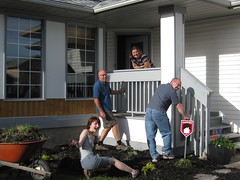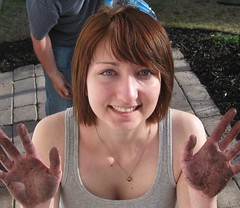Want better copywriting? Take a shovel to it!
June 08, 2009
I’m not what you would call a good gardener – but my friend Janine is. It seems that with a simple flick of her green thumb, Janine’s gardens magically transform into captivating arrays of colour, fragrance and style. When she offered to bring her special touch to my sad front garden, I jumped at the chance.
While digging in the dirt and learning how to make my garden grow, it struck me that there were some definite similarities between creating a beautiful garden and writing engaging copy.

1. Know and understand before you dig
It’s hard to imagine what those little plants will look like once they’ve matured, but understanding their requirements – be it sun, shade, fertilizer or bees – enables you to treat them properly and address their needs so that they do what you want them to.
Before digging into copy, we have to know what kind of “garden” we want to grow. Who will read your words? What are their needs and desires? Why would they want your product or service? And what action will we want them to take once they read the copy? Sign up for a newsletter? Buy something from you?
Writing copy without having a sense of the people we want to speak to – and what we wish to say to them – is like throwing random packets of seeds on the ground in the hope that the right plants will come up.
2. Save only what needs to be there
OK, this hurt a little, but we dug up the entire garden and didn’t put everything back. We even bought some new plants to take their place! That’s because my garden was a discombobulated mess of things that I liked and that I thought needed to be there. But in actual fact, with everything squished into one area, plants were getting root-bound and stagnant, the soil couldn’t support their nutritional needs, and nothing was working.
It’s common to want to say everything upfront, and especially natural to want to “we we we” all over the place. However, just because we think it needs to be there doesn’t mean potential customers agree. If it’s not serving the needs of your target market, it’s just a bunch of words that are getting in the way of your intentions.
Copywriting is far more effective when the story invites readers in and gradually reveals itself in a comfortable, engaging way. Lead with the points that resonate with them and provide supporting details later on to flesh your message out.
Most of the excess plants found their way into the back garden. So, there was a place for them after all.
3. Keep it simple, clear and focused
The rule, Janine told me, is to keep the same plants together in groups of uneven numbers to enhance the overall appeal of the garden. What’s more, don’t overcrowd them. Leave breathing space between the plants for a clean, streamlined look.
In keeping with our garden analogy, copy messages that support a thought thread should always be grouped together. For example, if you sell time management software, you could devote a block of copy to explaining the ways in which it improves productivity. Another copy block might detail how easy it is to use. A third section may talk about the research behind this quality product. And another section would tell the customer how to purchase it. You get the idea.
Make clean breaks between your copy blocks with subheads, and use shorter sentences, colloquial words and bullet points where appropriate. This enables your reader to easily scan the material and absorb the information in a more comfortable way.
4. Tie everything together with a unifying theme
To finish things off, we laid a layer of mulch between the plants. Not the usual brown chips of cedar either: we used coal-black mulch. We added a small flagstone walkway and two black trellises for the clematis to climb. The final effect is a wonderful combination of greenery, dashes of brilliant colour, and classic black accents.
The lesson here is that your story must have a theme for a few reasons: to attract attention, to help your message flow, and to make for an enjoyable read. Start with a creative headline that sets the tone. Carry that theme through in the subheads. Support it with copy that is fresh and alluring. Add visuals that are linked to the theme for more impact.
5. Ask an expert for help
I am so excited to watch my little garden blossom over the summer. But I couldn’t have done it alone. I don’t have the time or the experience to do the job right. I needed someone who had the know-how and the vision to turn it into something really special.
This lesson speaks for itself. If you’re having trouble coaxing your garden to grow, perhaps it’s time to hand the shovel over.


Great advice – especially “save only what needs to be there”. I do a lot of testing of web copy, and cutting down the copy almost always improves conversion. It forces you to be concise, yet powerful.
good stuff!
There are definite lessons here.